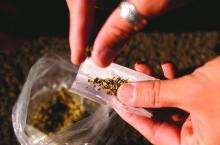The legalization of recreational marijuana use is associated with an increase in use of the drug among adolescents, who also perceive it as being less harmful, a new study published online suggests.
In the study, Magdalena Cerdá, DrPH, MPH, and her associates used data from the Monitoring the Future study – a national, annual, cross-sectional survey conducted by the University of Michigan, Ann Arbor, that looks at attitudes about drug use among students in 8th, 10th, and 12th grade. The investigators analyzed the data gathered from 2010 to 2015 in an effort to compare attitudes about marijuana and its use before and after legalization in Washington and Colorado, and in states that did not legalize.
In Washington State, the perceived harmfulness of marijuana declined by 14.2% among 8th graders and 16.1% among 10th graders after legalization, while marijuana use in the previous 30-day period increased by 2% and 4.1%. Over the same period in states that did not legalize, perceived harmfulness decreased by 4.9% among 8th graders and 7.2% among 10th graders, while marijuana use actually decreased by 1.3% and 0.9%. The differences between the 8th and 10th grades in Washington vs. the nonlegalized states were statistically significant (JAMA Pediatr. 2016. Dec 27. doi:10.1001/jamapediatrics.2016.3624).“While the increase in marijuana use among 8th graders in Washington was not significantly greater than zero, the significant decrease in use among 8th graders in states [with no recreational marijuana laws] suggests that if there had been no legalization in Washington, then marijuana use among 8th graders in this state would decrease rather than remain stable, as it did,” wrote Dr. Cerdà of the emergency medicine department at the University of California, Davis, in Sacramento, and her coauthors. “Specifically, the prevalence of regular users of marijuana increased and the prevalence of nonusers decreased; no change was observed among occasional users.”
Legalization, however, did not appear to significantly affect perceived harmfulness or use among 12th graders in any states, nor were there any significant changes after legalization among adolescents in all three grades surveyed in Colorado.
The authors noted that Colorado had a well-developed medical marijuana program in place, with substantial advertising, which might account for the lack of apparent impact of legalization for recreational use.
Commenting on the overall impact of legalization on use, the authors suggested that, besides reducing stigma and perceptions of risk, the legalization of recreational marijuana might have increased availability and potentially decreased the price, which might have led to the increase in use.
Given this, they cautiously proposed increased investment in evidence-based adolescent substance use prevention programs in states that choose to legalize recreational marijuana.
Dr. Cerdá and her associates cited several limitations. For example, the use of marijuana was self reported, and the Monitoring the Future results might have missed adolescents who were either absent from school when the survey was taken or had dropped out.
The study was supported by the National Institute on Drug Abuse, the National Institutes of Health, the National Institute on Alcohol Abuse and Alcoholism, and the New York State Psychiatric Institute. No conflicts of interest were declared.


